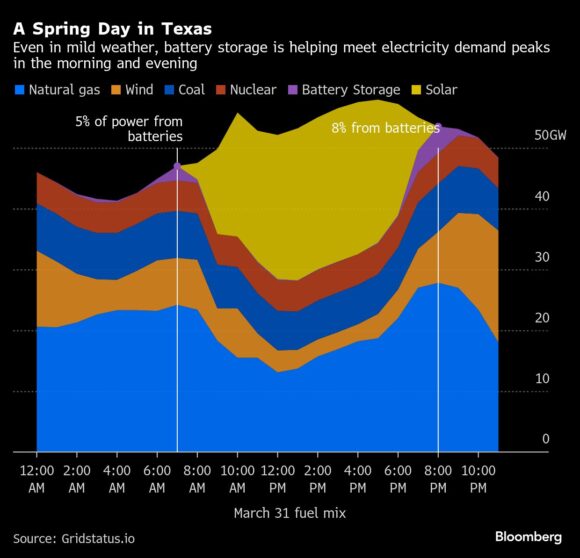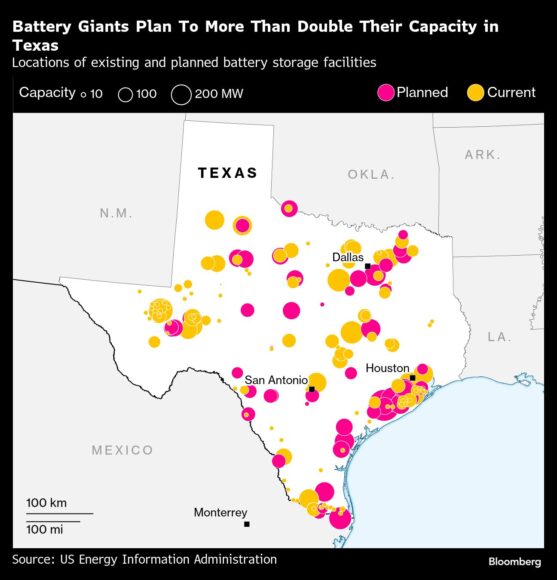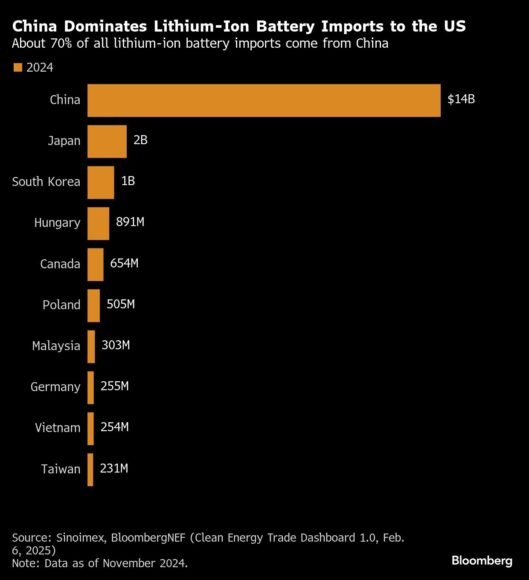Texas is the zero of the American battery mutation
“Drilling, child, drilling” may be the unofficial Texas logo, but “the store, the child, the store” has become more accurate.
Lone Star State may be the heart of the oil and gas map in America, but it soon became the largest installation of the technology key to develop renewable energy sources: storing the battery.
Last year, about 4 GB of battery capacity – enough to operate about 3 million homes – was operated in the state, better for the speed of similar projects in California for the first time. Before Donald Trump imposed 125 % on a tariff on the main battery market China, Texas was appointed to add more than twice the total storage capacity in the state in 2025, according to Bloomberg Green Federal energy data analysis.
Large batteries deal with some of the biggest problems facing the electrical network that now has the most renewed ability in the country. On the side of the show, they can carry the abundance of wind and the resulting solar energy throughout the state. On the demand side, they help meet the increasing needs of new residents and an increased number of electric vehicles and servers in data centers.
“What we have done over the past two years is really building a new industry that has proven to be widely implemented,” said Randolf Man, CEO of ESVOLTA LP, a battery startup that expects to be widely implemented. “We are doing it environmentally useful and we are able to do it very quickly.”
Think about the form of state energy in the past seven days, a medium week of spring weather in the state of Lun Star. When the demand reached its peak around 5 pm local time, nearly half of the electricity in Texas came from solar and wind. During sunset, the large batteries began to empty the electrons they made during the day when the bulk electricity price is hovering near zero. The storage served more than 7 % of the state’s electricity demand for 25 hours a week, usually around 7 pm, when Texas was watching TV, washing and connecting their cars all night. Although natural gas remains the main source of electricity in the state, the batteries steadily decrease the demand peaks that require fossil fuel turbines to run in life.

Moreover, the batteries can prevent energy disasters such as power outages, which is not strange in recent years. During a series of heat waves last summer, the additional storage saved consumers from “some very bad situations,” according to Woody Rekerson, Executive Director of Operations in the Electrical Trustees Council in Texas, which runs the state network.
Batteries are still chasing renewable energy in Texas. The country has about 64 GB of wind capacity and solar capacity, but only about 7.4 GB of storage.
While California and a group of other states are actively cultivating the battery storage with subsidies and objectives, the Texas infrastructure mutation is largely as a result of the free market, according to the Bloombergvist Ishu Kikuma analyst. “The driver is actually the project economies,” he said. “Some facilities are actually using energy storage to replace fossil fuel assets” and batteries make them “you can just earn money.”

The cost of building battery plants has decreased by half since 2017, according to Bnef.
Although recently implemented definitions on China will have a strong negative impact on the batteries industry. Without a tariff, Bnef estimated that the cost of industrial storage has decreased by 13 % to $ 204 per kilowatt hour this year. Now, the key delivery system will cost $ 266 per kilowatt hour, an increase of 17 % compared to last year.
While Trump said that some countries, including Vietnam, are keen to negotiate the customs tariff because it stops for 90 days, China has moved to revenge and Trump escalated. The various reactions and uncertainty are scheduled to be a preposition in the industry, as more than two thirds of the batteries imported from China come.

Texas battery mutation can be suffocated through other policy decisions. The batteries and facilities that are increasingly dependent on them are concerned that Congress is to cancel the federal tax credit by 30 % for solar energy projects and storage as part of his pledge to cancel climate -focused support. Former President Joe Biden signed a law to motivate batteries to create a store in the United States, but it will take years to increase production facilities. (This incentive may also be at risk of removing or watering.)
Meanwhile, the legislators in Texas weigh a plan to require half of the new energy capacity to come from sources other than storing batteries, a shift in politics that would support the natural gas industry.
“We need very good clarity of our capital costs and we have clearly over time because we are building five years to develop it,” said Man of Esvolta from Man. ))
Photo: Houston’s battery storage complex. Photographer: Jason Votcheman/Houston Cronic/Getty Em.
Copyright 2025 Bloomberg.
Subjects
USA Texas
The most important insurance news, in your inbox every working day.
Get the reliable newsletter for the insurance industry





